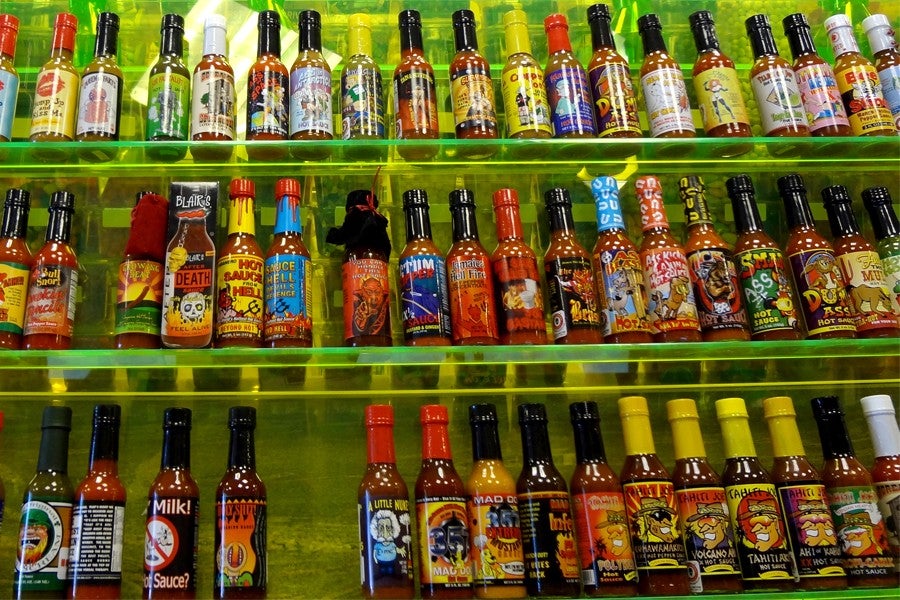For many (usually white) Americans who claim to like hot sauces, there are typically two schools of thought: There are those who think spearmint toothpaste is too spicy but will have a dab of Sriracha when in need of a little flavor. (Sriracha itself has become much more than a condiment, one of the first casualties in the wave of things memed to death by the internet.) Meanwhile, the others are focused strictly on pain. They’d like to drill straight through Flavortown into Flavor Hell. These people might put some on a tablespoon and snort it, if not mainline a whole pepper before it can even be turned into a condiment. This isn’t the element of a meal, it’s a viral and disturbing YouTube video.
Both sides miss the point, by a wide margin. Daylight exists between these extremes — i.e., there can be flavor and a solid, satisfying burn. Instead, though, we’ve set the bar so, so low in terms of heat. But why?
Basically, hot sauce has an image problem. Which is why we need actual hotter hot sauce, available for the everyday person. Something better than Tabasco, but less insane than Blistered Bunghole, Angry Asshole or Ass Blaster. (Ass-destroying hot sauces — hell and death are also popular themes — mostly taste like shit and are usually designed solely with heat in mind, never flavor, and consuming them is a party trick where the trick is trying not to die.)
Now, admittedly, I care a little too much about hot sauce. I remember staring, fascinated, at my dad sweating as he ate, telling us how good a certain chicken curry was. To me, it looked like he was having a stroke. But soon I began seeking out that same feeling with almost every meal. It could be genetic. A cousin of mine shares an affinity for hot sauces, and after watching the web series Hot Ones, he got the hottest sauce on that show. I tried it, then bought it myself, and very quickly ran out of it. Later, an uncle introduced me to the severely underrated West Indian scotch bonnet sauce. All of which is to say that my blood might have a decent Scoville level.
As such, I recently made a pilgrimage to the mecca of hot sauce — the Pepper Palace, a nationwide speciality hot sauce store. Located in the Fisherman’s Wharf neighborhood of San Francisco, this Palace is mostly (if not exclusively) frequented by curious tourists. There are several containers of chips, which you can take (with tongs, please) and drop sauces upon.
I also find Chet, a hot sauce expert, inside. He explains some of the characteristics of peppers, which is helpful in deciding what sauces might be of interest to you. A serrano pepper, for example, has “small, citrusy notes to it” and “a little bit of sweetness and spice.” He compares it to the taste and smell of a bell pepper, just on a more “pungent, massive scale.” Jalapeños, on the other hand, aren’t so citrusy. They’re more “meaty” and have more juice to them. Habañeros, Chet says, have “a slight tropical taste,” but you need to pay attention in order to sense it.
Beyond that point, we start dipping into the realm of ghost, scorpion and reaper peppers. Chet, however, stays away from them because they’re too hot, he says. Nor do they smell natural. For reference: Cayenne peppers, the source of heat in Tabasco, have a Scoville rating of 30,000 to 50,000; ghost peppers register from 855,000 to more than 1 million Scoville units.
While discussing some of our favorite sauces — his is “Ghostly Garlic,” a blend of ghost, habañero and cayenne peppers; mine is a mustard-based sauce made with Carolina Reaper peppers — I ask him why the general public seems to have settled on the (relatively) bland Tabascos, Cholulas and Srirachas of the world. “People just know about them,” he responds. “It’s hard to just throw something on your food that you don’t know if it’s going to taste good, especially when you just bought it.”
Chet does, though, notice a generational difference in sauce preference. “When we get customers here in their 30s who have been eating peppers for a really long time, they typically go for sauces that are loaded with peppers,” he says. “When kids walk in here, guess which sauce they buy? The hottest one. It’s loaded with capsaicin extract. They don’t care if they taste pepper; they just want to take the heat. For them, it’s more macho, more challenge-y.” (For reference: Capsaicin extract, Chet explains, is also the key ingredient in pepper spray.)
I wish we could somehow bridge the gap — a sauce with heat that tasted good, too (or that didn’t require ingredients also found in self-defense paraphernalia). It sounds melodramatic, but I truly believe that such a sauce could help foster a better understanding between cultures. To share a meal with someone when you’re both sweating is to share an intimate connection. It’s to leave the table knowing them better than you did before. A quality spicy meal, with a comfortable amount of discomfort, is to take a mini-trip through pain, pleasure, and in extreme cases, relief.
A recent BBC story explains it well. While it may seem counterintuitive, spice-loving people are just as sensitive to heat as “regular” people. They’re just aware it won’t kill them, and that they may be participating in something called “benign masochism.” And take it from me, this self-inflicted flagellation of the gustatory senses is worth experiencing and meditating on.
Come to think of it, Benign Masochism isn’t such a bad name for a sauce either. At the very least, it beats Ass in the Tub.

